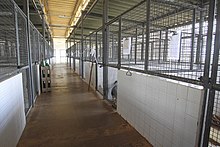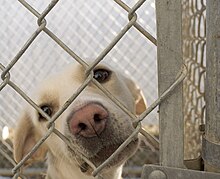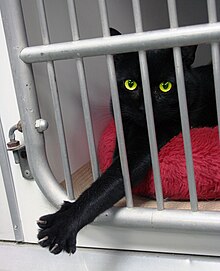what do they do to dogs at the pound

Outdoor kennel runs at a shelter

Indoor dog kennels at a shelter

A dog at an animal shelter

A cat at an animal shelter
An animal shelter or pound is a place where stray, lost, abandoned or surrendered animals – mostly dogs and cats – are housed. The discussion "pound" has its origins in the animal pounds of agronomical communities, where stray livestock would be penned or impounded until they were claimed past their owners.
While no-kill shelters be, information technology is sometimes policy to euthanize animals that are not claimed speedily enough by a previous or new owner. In Europe, of the thirty countries included in a survey, all but vi (Republic of austria,[1] the Czechia,[2] Frg, Greece, Italian republic and Poland[3]) permitted euthanizing non-adopted animals.[4]

Terminology [edit]
The shelter industry has terminology for their unique field of piece of work, and though in that location are no verbal standards for consistent definitions, many words have meanings based on their usage.[5]
Animal control has the municipal part of picking up stray dogs and cats, and investigating reports of animal abuse, dog bites or creature attacks. It may also be called animal care and control, and before was called the dog catcher or rabies control. Stray, lost or abased pets picked up off the streets are usually transported to the local animal shelter, or pound. Uncomplicated stray cases are usually kept for a period of time, called stray hold. After the belongings flow, an creature is considered forfeited by its owner, and may become available for adoption. Animals involved in attacks or bites are placed in quarantine and are not available for adoption until investigations or legal cases are resolved. Creature control'south involvement is mainly public safety and rabies control.[5] [half dozen]
Many shelter policies let individuals to bring in animals to the shelter, often called owner surrender, or relinquishing an animal. An open up admission shelter will accept whatever animal regardless of reason, and is ordinarily a municipal-run shelter or a private shelter with a contract to operate for a municipality. Municipal shelters may limit incoming animals to those from the expanse in which they serve. A managed admission shelter requires an appointment and will restrict admission of animals to fit their bachelor resource. Limited admission shelters are usually private or not-profit shelters without municipal contracts, and they may limit their intake to only highly-adoptable and healthy animals.[five] [6]
An animal in a shelter has four outcomes: return to owner, adoption, transfer to another shelter or rescue facility, or euthanasia.[half-dozen] Render to owner is when a devious animal, that was found and housed at the shelter, is picked up by its possessor. Most animate being shelters practise adoption, where an animal in their care is given or sold to an individual who will keep it and care for it. Some shelters work with rescue organizations, giving an animal to the rescue rather than adopting it to an individual. Some jurisdictions mandate that shelters cooperate with rescues; some shelters use rescues to offload animals with health or behavior problems that they are not equipped to deal with. Many shelters practice some level of euthanasia.[5] [vi]
Euthanasia is the act of putting an animal to death. A high kill shelter euthanizes many of the animals they take in; a low kill shelter euthanizes few animals and ordinarily operates programs to increase the number of animals that are released alive. A shelter's live release rate is the measure out of how many animals go out a shelter live compared to the number of animals they accept taken in. A no impale shelter practices a very strict high live release rate, such as 90%, 95%, or fifty-fifty 100%. Since there is no standard of measurement, some shelters compare live releases to the number of healthy, adoptable animals, while others compare alive releases to every animal they took in – as such, the terms high kill, low kill, and no kill are therefore subjective.[5] [6]
Shelter partners include rescue groups, fosters and sanctuaries. Rescue groups will oftentimes pull dogs from shelters, helping to reduce the number of animals at a shelter. A rescue group often specializes in a specific dog breed, or they pull hard-to-adopt animals such as those with health or behavioral issues with the intention of rehabilitating the creature for a hereafter adoption. Many rescues don't take brick and mortar locations but operate out of a dwelling or with foster partners. A foster will temporarily take animals from the shelter to their home to give them special attention or care, such as a newly whelped litter of puppies, or an beast recovering from an affliction. An animal sanctuary is an alternative to euthanasia for difficult-to-adopt animals; it is a permanent placement which may include secure kenneling and care by staff experienced in the treatment of animals with serious aggression or permanent behavioral problems, or a home for anile animals that will be cared for until their natural death. Adoption and sending to rescue or sanctuary are permanent placements; fostering is a temporary placement.[5] [6]
A retail rescue takes advantage of right-of-kickoff-choice of the free or inexpensive inventory of animals from shelters to flip shelter-pulled animals under the banner of 'adoption', with little or no retraining or veterinary care in between pulling a canis familiaris and selling it. They may besides obtain animals cheaply from auctions or puppy mills and command high dollar for their adoptions under the ruse of having 'rescued' the creature. A retail shelter operates like an ordinary animal shelter but with more of the flavor of a pet store than a traditional shelter by selling pet supplies. They may even obtain animals from out of the expanse to increase their inventory of animals, rather than serving only their geographic service area.[6]
Many shelters routinely spay or neuter all their adoptable animals and vaccinate them for rabies and other routine pet diseases. Shelters oftentimes offer rabies clinics or spay-neuter clinics to their local public at discount rates. Some shelters participate in trap–neuter–render programs where stray animals are captured, neutered and vaccinated, and so returned to the location they were picked upwards.[5] [6]
By state [edit]
Canada [edit]
In Quebec, there are ii types of brute shelters:[ citation needed ]
- SPCA (in French, 'Société pour la prévention de la cruauté envers les animaux')
- SPA (in French, 'Société protectrice des animaux')
Germany [edit]
Larger cities in Germany have a city shelter (Tierheim) for animals or contract with one of the many not-profit animal organizations in the country, which run their ain shelters. Nearly shelters are populated by dogs, cats, and a variety of minor animals similar mice, rats, and rabbits. Additionally, at that place are so-called Gnadenhöfe ("mercy-farms") for larger animals that take cattle or horses from private owners who want to put them down for financial reasons.
The Animal Protection Act prohibits killing of vertebrates without a proper reason. Mostly, proper reasons are slaughtering or hunting for nutrient product (cats and dogs are excepted from that), command of infectious diseases, painless killing "if continued life would imply uncurable hurting or suffering" or if an animal poses a danger to the general public.[7] The latter will be a reason for euthanasia only if an authority concerned with public safety orders it based on an investigation. Because of the ruling, all German animal shelters are practically no-impale shelters. Facilities must be led past a person who is certified in the handling of animals. Most shelters contract veterinarians to provide medical intendance.
Bharat [edit]
Goshalas are a type of shelter for homeless, unwanted or elderly cattle in Bharat. Cows are venerated by many Hindus and slaughter of cattle is illegal in nigh places in the country.[8]
New Zealand [edit]
In New Zealand, canis familiaris pounds are run by each territorial local authority, which provide animal control services under the Dog Control Act 1996.[9]
Poland [edit]
In Poland, it is allowed to euthanize animals in shelters only because of illness.[3] Yet, it is permitted to kill blind litters as they are considered dependent.[10]
United kingdom of great britain and northern ireland [edit]
In the U.k., animal shelters are more normally known every bit rescue or rehoming centres and are run past charitable organizations. The about prominent rescue and rehoming organizations are the RSPCA, Cats Protection and the Dogs Trust.[ citation needed ]
United States [edit]
In the United States there is no regime-run organization that provides oversight or regulation of the various shelters on a national basis. However, many individual states regulate shelters within their jurisdiction. 1 of the earliest comprehensive measures was the Georgia Animate being Protection Human activity of 1986, a law enacted in response to the inhumane handling of companion animals by a pet store chain in Atlanta.[xi] Information technology provided for the licensing and regulation of pet shops, stables, kennels, and beast shelters, and it established, for the first time, minimum standards of care. The Georgia Department of Agriculture was tasked with licensing creature shelters and enforcing the new law through the Department's newly created Animal Protection Division. An additional provision, added in 1990, was the Humane Euthanasia Act, the beginning state constabulary to mandate intravenous injection of sodium pentothal in place of gas chambers and other less humane methods.[12] [13] The law was further expanded and strengthened with the Creature Protection Human activity of 2000.[14]
Currently, it is estimated that there are approximately 5,000 independently-run animal shelters operating nationwide.[fifteen] Shelters have redefined their part since the 1990s. No longer serving equally a lifelong repository for strays and drop-offs, modern shelters have taken the pb in decision-making the pet population, promoting pet adoption and studying shelter animals' wellness and beliefs. To foreclose animal euthanization, some shelters offer behavioral assessments of animals and training classes to make them more adoptable to the public. Nigh shelters also provide medical care that includes spaying and neutering to prevent overpopulation.
Shelters and shelter-like volunteer organizations responded to true cat overpopulation with trap-neuter-return (TNR) programs, which reduced feral cat populations and reduced the burden on shelters.
In the United States, many government-run animal shelters operate in weather that are far from platonic. In the wake of the financial crisis of 2007–2008, many government shelters ran out of adequate space and financial resources.[16] Shelters unable to raise additional funds to provide for the increased number of incoming animals have no pick but to euthanize them, sometimes within days.[17] In 2012, approximately four million cats and dogs died in U.Southward. shelters.[18] Even so, in recent years, there has been a dramatic drib in the number of animals euthanized in shelters, due mainly to a successful push to promote spaying and neutering of pets.[19]
Meet also [edit]
- Animal control service
- Pet adoption
References [edit]
- ^ Unternehmensberatung, ADVOKAT. "§ vi TSchG (Tierschutzgesetz), Verbot der Tötung - JUSLINE Österreich". www.jusline.at. Archived from the original on 16 October 2019. Retrieved 16 Oct 2019.
- ^ "246/1992 Coll. Law Czech National Quango to protect animals confronting cruelty (paragraph xiii)". portal.gov.cz. Archived from the original on 17 May 2017. Retrieved iii January 2017.
- ^ a b "Smooth Animal Protection (Amendment) Human action 1997" (PDF). sejm.gov.pl. 28 March 2000.
{{cite web}}: CS1 maint: url-status (link) - ^ Tasker, Louisa. "Stray Creature Command Practices (Europe)" (PDF). World Society for the Protection of Animals and RSPCA International. p. 18. Archived (PDF) from the original on 26 Nov 2019. Retrieved 24 August 2020 – via Devious Creature Foundation Platform.
- ^ a b c d eastward f g "Shelter Terminology" (PDF). Clan of Shelter Veterinarians. February 2017. Archived (PDF) from the original on 24 August 2020. Retrieved 24 August 2020.
- ^ a b c d e f g h "Glossary | NAIA Shelter Projection". National Animal Interest Alliance. Archived from the original on 17 February 2020. Retrieved 24 August 2020.
- ^ "Tierschutzgesetz (Animal Protection Human action) (High german)". Archived from the original on two February 2017. Retrieved 15 Feb 2017.
- ^ Sharma, Arvind; Schuetze, Catherine; Phillips, Clive J.C. (28 January 2020). "The Management of Cow Shelters (Gaushalas) in India, Including the Attitudes of Shelter Managers to Cow Welfare". Animals. 10 (two): 211. doi:x.3390/ani10020211. PMC7070297. PMID 32012807.
- ^ "Dog Control Deed 1996". Archived from the original on eleven March 2015. Retrieved 17 March 2015.
- ^ "Reply of the Undersecretary of Land in the Ministry of Agriculture on the killing of blind litters on the basis of the interpretation of the provisions of the Fauna Protection Act". sejm.gov.pl. 3 April 2021.
{{cite spider web}}: CS1 maint: url-status (link) - ^ "Animal Protection – Ga Dept of Agriculture". Agr.georgia.gov. Archived from the original on 21 October 2012. Retrieved 16 October 2012.
- ^ "Georgia Humane Euthanasia Human activity, O.C.G.A. §4-11-v.1". Fauna Law Coalition. Archived from the original on 10 November 2012. Retrieved 16 October 2012.
- ^ "Judge Issues Permanent Injunction Confronting Illegal Use of Gas Chambers in Georgia". Fauna Law Coalition. Archived from the original on 22 January 2013. Retrieved 16 Oct 2012.
- ^ "Georgia Animal Protection Deed". Animallaw.info. Archived from the original on 13 Nov 2012. Retrieved sixteen October 2012.
- ^ "Pet Statistics". ASPCA. Archived from the original on 17 October 2012. Retrieved 16 October 2012.
- ^ Diamond, Wendy (13 May 2007). "America'due south Foreclosed Pets". HuffPost. Cleveland. p. ane. Archived from the original on xv June 2009. Retrieved six August 2009.
- ^ Lewis, Laura Dawn (2009). Laid Off, At present What?!? Financial Savvy, Volume 1. Couples Company, Inc. p. 29. ISBN978-0-9671042-6-3.
- ^ Milky way, Jackson (2012). Cat Daddy: What the World's Almost Incorrigible Cat Taught Me About Life, Dearest, and Coming Clean. New York, New York: Penguin Group (USA) Inc. p. 3. ISBN978-1-101-58561-0. Archived from the original on 24 August 2020. Retrieved 23 June 2019.
- ^ Parlapiano, Alicia (3 September 2019). "Why Euthanasia Rates at Brute Shelters Have Plummeted". The New York Times. Archived from the original on 24 Feb 2020. Retrieved 24 February 2020.
Source: https://en.wikipedia.org/wiki/Animal_shelter
Post a Comment for "what do they do to dogs at the pound"